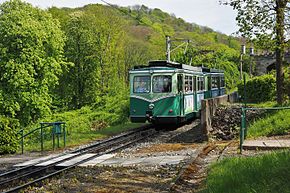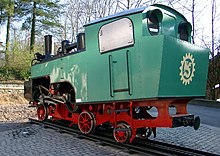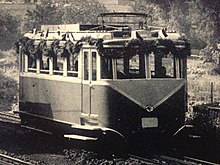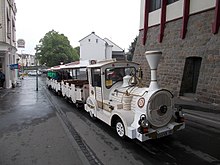Drachenfelsbahn
| Königswinter – Drachenfels | |||||||||||||||||||||||||||||||||||||
|---|---|---|---|---|---|---|---|---|---|---|---|---|---|---|---|---|---|---|---|---|---|---|---|---|---|---|---|---|---|---|---|---|---|---|---|---|---|
|
Railcars 6 and 3 at the pedestrian crossing
below Drachenburg Castle | |||||||||||||||||||||||||||||||||||||
| Course book section (DB) : | 11001 | ||||||||||||||||||||||||||||||||||||
| Route length: | 1.520 km | ||||||||||||||||||||||||||||||||||||
| Gauge : | 1000 mm ( meter gauge ) | ||||||||||||||||||||||||||||||||||||
| Power system : | 750 volts = | ||||||||||||||||||||||||||||||||||||
| Maximum slope : | 200 ‰ | ||||||||||||||||||||||||||||||||||||
| Rack system : | Riggenbach | ||||||||||||||||||||||||||||||||||||
|
|||||||||||||||||||||||||||||||||||||
The Drachenfelsbahn is the oldest operated rack railway in Germany . It is operated by Bergbahnen im Siebengebirge AG according to its own “building and operating regulations for the Drachenfelsbahn”, or “BO-DRACH” for short . The meter-gauge railway has been connecting the old town of Königswinter , located in the Rhine Valley , with the Siebengebirge since 1883 and ends just below the Drachenfels summit. The 1520 meter long route overcomes 220 vertical meters , the maximum gradient is 20 percent. The Drachenfelsbahn is one of the most frequently used cog railways in Europe; by 2008 it carried more than 35 million passengers. In addition to the Bavarian Zugspitzbahn , the Wendelsteinbahn and the Stuttgart rack railway , the Drachenfelsbahn is one of only four rack railways still in operation in Germany. It is completely laid on steel sleepers.
history
In 1881, the German Local and Tram Company in Berlin applied for a concession for a mountain railway up to the Drachenfels. The approval was given on August 29, 1881 by the Cologne District President. The first passenger journey took place on July 13, 1883; four days later the Drachenfelsbahn was officially opened as the first German cog railway with public passenger transport. The railway was considered a technical sensation and a crowd puller. Through it, visitors were able to reach the Drachenfels summit and the Drachenfels castle ruins for the first time without the arduous ascent. The Drachenburg Castle, completed in 1884, later became a popular destination for excursions by train. There is the only intermediate station of the railway, which was rebuilt in a modernized form from March 2010 to May 2011.
In 1913, the German local and tram company separated from their mountain railway. The new owner was the Cologne entrepreneur Ferdinand Mülhens , boss and owner of the world-famous house 4711 . Ten years later, on July 13, 1923, he finally merged the Drachenfelsbahn with the neighboring Petersbergbahn to form Bergbahnen im Siebengebirge AG, which still exists today .
On June 12, 1953, the railway was switched to electric drive, but initially only operated one electric multiple unit (ET I). Little by little, more railcars were purchased, which gradually replaced the steam trains. These vehicles from the 1950s are still in use today, with the exception of ET I. Since 1982 the vehicle numbers have been written in Arabic numerals . These replace the vehicle numbers previously given in Roman numerals .
A serious accident occurred on September 14, 1958: the steam locomotive on the last descent on that day derailed due to excessive speed because the brakes failed. 18 people died, 112 were also injured.
Planned cable car to Rhöndorf
In the early 1950s there were considerations to build a cable car from Rhöndorf to the Drachenfels. The local companies - above all the master baker and CDU city councilor Peter Profittlich († 1963) - promised to generate additional sales through the expected tourists. One opponent of this project was the then Federal Chancellor Konrad Adenauer , who lived in Rhöndorf and rejected the expected unrest from tourists. At the end of February 1959, the application made in April 1953 was rejected by the NRW state government "for nature conservation reasons".
Drachenfels tourist station
The Drachenfels tourist station is located at the foot of the Drachenfels . In the partially rebuilt valley station of the Drachenfelsbahn, an exhibition on the sights of the Siebengebirge is housed next to the tourist information. There you will find the glass workshop of the railway and an exhibition about the history of the Drachenfels railway. On the upper floor of the train station, a model railway system will be demonstrated on an area of 22 m². This shows part of the old town of Königswinter, the valley station, the route with the villas and Drachenburg Castle and the mountain station with the Drachenfels in 1927.
The steam locomotive No. 2 "has been a memorial in front of the valley station since 1968. During its restoration in 2005 in Poland, the rail clearers were reversed to the left and right of the two gears, some missing parts were not added and the locomotive was given a green color, which is not the original Since the steam locomotive No. 2 "is a cultural monument and is under monument protection, the rail clearers have been correctly installed again in the meantime.
Postage stamps
On the occasion of the 125th anniversary of the Drachenfelsbahn, a stamp designed by graphic designer Lutz Menze was issued on July 3rd, 2008.
vehicles
Steam locomotives
| Road no. | design type | Manufacturer | Construction year | Serial number | Drachenfelsbahn | further use | Illustration |
|---|---|---|---|---|---|---|---|
| 1 | 2 / a-n2t | Esslingen | 1883 | 1982 | 1883-1929 ++ 1929 | ||
| 2 | 2 / a-n2t | Esslingen | 1883 | 1983 | 1883-1927 ++ 1927 | ||
| 3 | 2 / a-n2t | Esslingen | 1883 | 1984 | 1883-1927 ++ 1927 | ||
| 1 II | (2) 1 '/ b-h2t | Esslingen | 1929 | 4225 | 1929-19xx | 19xx – 1958 Petersbergbahn ++ 1958? | |
| 2 II | (2) 1 '/ b-h2t | Esslingen | 1927 | 4185 | 1927–1958 + after October 14, 1958 | In 1959 it was parked in the cold, erected as a memorial at the valley station of the Drachenfels railway in Königswinter since 1968, in 2005 the exterior was refurbished and covered | |
| 3 II | (2) 1 '/ b-h2t | Esslingen | 1927 | 4187 | 1927–14.10.1958 +14.10.1958 ++ 1958 | Badly damaged in the accident on September 14, 1958 and then examined to clarify the cause of the accident | |
| 4th | (2) 1 '/ b-h2t | Esslingen | 1928 | 4220 | 1928-1951 | 1951–1958 Petersbergbahn ++ 1958? | |
| 5 | (2) 1 '/ b-h2t | Esslingen | 1926 | 4161 | 1926-1938 | ? –1938 Petersbergbahn; 1938–1939 Niederwaldbahn , Rüdesheim as "Saar"; 1939–1952? ++ 1952 |
Presentation car
| Road no. | design type | Manufacturer | Construction year | Serial number | Drachenfelsbahn | further use | Illustration |
|---|---|---|---|---|---|---|---|
| 1 | 1883 | 1883-1958 | Whereabouts unknown | ||||
| 2 | 1883 | 1883–1958 + October 14, 1958 after an accident ++ | |||||
| 3 | 1883 | 1883–1958 + October 14, 1958 after an accident ++ | |||||
| 4th | 1883 | 1883–1958 + October 14, 1958 after an accident ++ | |||||
| 5 | 1883 | 1883-1958 + 1958 | Whereabouts unknown | ||||
| 6th | 1883 | 1883-1958 + 1958 | Whereabouts unknown | ||||
| 3 II | 1884 | 1950; 1953 +1953 due to renovation | 1884–1950 Niederwaldbahn Rüdesheim; 1950 Conversion to a closed car body with steam heating for the service of the Allied High Commission to Petersberg; 1950–1953 Petersbergbahn; 1953 conversion to ET I +1963; 1963 parked at the disused Petersbergbahn; 1963–? as a building shack in Bonn-Beuel |
The presentation cars 1 to 6 had four compartments, the presentation car 3 II ex. Niederwaldbahn five.
Freight wagons
| Road no. | design type | Manufacturer | Construction year | Serial number | Drachenfelsbahn | further use | Illustration |
|---|---|---|---|---|---|---|---|
| (1) | Low side car | DIY? | 1883 | ? | 1883 II | between 1889 and 1957 also at the Petersbergbahn i. E .; 2019 at the Drachenfelsbahn as a workshop vehicle i. E. |
Railcar
| Road no. | design type | Manufacturer | Construction year | Serial number | Drachenfelsbahn | further use | Illustration |
|---|---|---|---|---|---|---|---|
| ET I (3 II ) | 2 / a-el | Homemade / BBC | 1884/1953 | ? | 1953–1963 +1963 | 1963 parked at the disused Petersbergbahn; 1963–? as a building shack in Bonn-Beuel | |
| ET 2 (ET II) |
2 / a-el | Rastatt / BBC | 1955 | 3912 (000/0) | 1955-1982 ET II ; since 1982 ET 2 | ||
| ET 3 (ET III) |
2 / a-el | Rastatt / BBC | 1957 | 6011 | 1957-1982 ET III ; since 1982 ET 3 | ||
| ET 4 (ET IV) |
2 / a-el | Rastatt / BBC | 1959 | 6100 | 1959-1982 ET IV ; since 1982 ET 4 | ||
| ET 5 (ET V) |
2 / a-el | Rastatt / BBC | 1960 | 6144 | 1960-1982 ET V ; since 1982 ET 5 | ||
| ET 6 (ET VI) |
2 / a-el | Homemade / BBC | 1978 | 1978-1982 ET VI ; since 1982 ET 6 |
Remarks
- The steam locomotives (No. 1 II , 2 II , 3 II , 4 and 5) built between 1926 and 1929 were allowed to transport up to three display cars at the Drachenfels Railway per train journey . At the Petersbergbahn the steam locomotives no. 1 II , 4 and 5 only transport one presentation car each due to the steep incline. Locomotives 2 II and 3 II were never stationed on the Petersbergbahn.
- The ET I was not built from the presentation car no.1, but from the presentation car no.3 II (ex. Niederwaldbahn), which was retired there in 1952. This can be seen in the DVD film "75 Years of the Drachenfels Railway". Obviously, the presentation car 3 II was not retired, but enlarged and converted to make it weatherproof (similar to the presentation car 8 on the Petersbergbahn). Following this renovation, which was carried out at the Petersbergbahn, the 3 "display car remained with the Petersbergbahn for the time being. However, it was later used on the Drachenfelsbahn, where it was later converted into the ET I.
- Since the ET 2 to 6 are equipped with simplified Scharfenberg couplings, the freight wagon without a number can be coupled to an ET (2 to 6) using a simplified Scharfenberg coupling. However, this may only be done on the mountain side so that it is pushed when driving uphill.
- The freight car is a specialty. Its brakeman's platform points towards the valley, although it is common on cog railways that the brakeman's platform must point towards the mountain to monitor the route.
- The old overpass was dismantled around 1970. It was used to exchange vehicles between the Petersbergbahn and the Drachenfelsbahn. The length was about 100 meters.
- In 1975/76 the passing point was relocated to the current location.
- The track of the mountain station is partly on a so-called slope viaduct.
- The colors of the railcars or the colors of the vehicles from the steam locomotive era are identical to the corporate colors of the 4711 company .
- Color shades of display trolleys 1 to 8 and 3 II ** Frame: Jet black - RAL 9005.
- Door height outside: moss green - RAL 6005; Inside door height: clear lacquered natural wood.
- Window height outside: white green - RAL 6019; Window height inside and ceiling: white RAL 9010.
- Although the Drachenfelsbahn railcars are bidirectional, they only have doors on one side. This is only possible because the platforms at all three stations of the route discussed here are arranged on the same side, namely on the west side. The only exception on the Drachenfelsbahn was the ET I, which had doors on both long sides.
Trivia
Since 2006 the city of Königswinter has been offering civil marriages in one of the Drachenfelsbahn railcars. The official act is carried out in the mountain station with the car doors closed.
As a feeder from Königswinter to the valley station, the Drachenfelsbahn operates a railway called Lokomobil .
gallery
literature
- Angelika Schyma : City of Königswinter. (= Monument topography Federal Republic of Germany , Monuments in the Rhineland , Volume 23.5.) Rheinland-Verlag, Cologne 1992, ISBN 3-7927-1200-8 , p. 127.
Web links
- Website of the Drachenfelsbahn
- Private website about the Drachenfelsbahn and the Petersbergbahn
- Mountain railways in the Siebengebirge
- Picture gallery of the Drachenfelsbahn on railfaneurope.net
- The Drachenfelsbahn - a documentation with lots of photos, historical postcards, documents, videos
Individual evidence
- ↑ Bonner General-Anzeiger, July 16, 2008, page 9
- ^ The layout of a rack railway from Königswinter to the Drachenfels , Centralblatt der Bauverwaltung , October 21, 1882, p. 384, accessed on December 13, 2012
- ↑ Compilation of the permits issued in the Rhine Province up to 1896
- ↑ The Bad Honnef weekly newspaper: ANNIVERSARY: The Drachenfelsbahn is 125 years old ( Memento from November 24, 2012 in the Internet Archive ) from March 28, 2008.
- ↑ Petra Pluwatsch: The fight of the gladiators , Kölner Stadtanzeiger, April 4, 2016, page 9
- ↑ The Bad Honnef weekly newspaper: ANNIVERSARY: Drachenfelsbahn gets its own stamp ( memento from December 8, 2015 in the Internet Archive ) from June 30, 2008.
- ↑ Lokomobil on the website of the Drachenfelsbahn
Coordinates: 50 ° 40 ′ 29 ″ N , 7 ° 11 ′ 52 ″ E


















